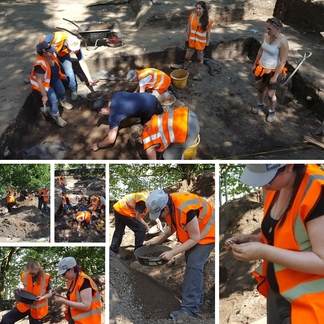 Scott's facts and findings
Welcome to Scott's seventh column. In this edition, he is going to give an insight into some of
the key discoveries from recent excavations which have taken place at the Castle.
"Since April, there has been an almost continuous presence of
archaeologists at the Castle. The team from Trent & Peak Archaeology has
been carrying out a series of excavations. In conjunction with previous
work, these build up a clearer understanding of this important site.
The investigations are to evaluate the
nature, extent and condition of archaeological remains which are to be
potentially affected by the proposed works for the Castle Transformation Project. The
work provides us with knowledge of where archaeological remains survive and
helps us create a construction strategy to minimise the effect of the building
works upon these traces of the site's past.
Two small trenches in the Outer Bailey, close to the gatehouse, revealed extensive landscaping deposits dating to between the 17th and early 20th centuries. The landscaping was largely associated with the construction of the Ducal Palace in the 1670s and preparation of the grounds when the building because a museum in the late 19th century. A crushed sandstone deposit was interpreted as a possible rough surface of uncertain, but likely late 17th century date.
|
 |
A medieval ditch was found in the Service Courtyard, where it is intended that the Rebellion Gallery will be constructed.
The ditch, which acted as a defence of the Inner Bailey where the Castle's Keep and key buildings were located, was shown to have fallen out of use during the 17th century.
Some probable medieval masonry, of uncertain function, was found within the ditch. The area was later covered with a cobbled surface (probably when the Ducal Palace was built) with two later paved surfaces.
Also associated with the Ducal Palace was a ramp or bridge which allowed carriages to be driven on to the Middle Bailey (The Green). A trench in the slope close to the circular flower beds revealed stone foundations.
And of course, there was the excavation in June that recovered the lower half of a human skeleton in the Middle Bailey (The Green). This has long been believed to be associated with the Civil War. Further details of this burial, including the radiocarbon dating results, will be revealed in next month's article."
 We Dig the Castle!
This is the project that is helping to undertake many of the excavations at the Castle. These involve the partnership of the City Council, Trent & Peak Archaeology, and Historic England.
On 16 July, the community excavation in the Outer Bailey, close to the bandstand, began with a family fun day.
Each week day, professional archaeologists are teaching some of the archaeological skills to groups of volunteers.
The excavation will continue until 19 August and is a continuation of the community excavation which took place last summer.
Last year 18th century garden features were revealed and this year it is hoped medieval layers will be reached.
Early discoveries include more garden features dating to the 18th century when much of the Outer Bailey was used to grow vegetables including potatoes.
Finds include fragments of pottery and even a musket ball: a remnant of the the Castle's important links to the Civil War.
The musket ball could even date to September 1643 when Royalist soldiers seized St Nicholas' Church and from the church tower bombarded the Outer Bailey, firing muskets, killing a man and causing unknown damage.
For further information regarding the excavations and to check avalability (places are very limited) please telephone: 0115 8967400 or email: nottinghamcastle@yorkat.co.uk
To find out more about last year’s excavations and the latest updates from this year’s dig, please visit the project Facebook page or follow @wedigthecastle on Twitter
|
|